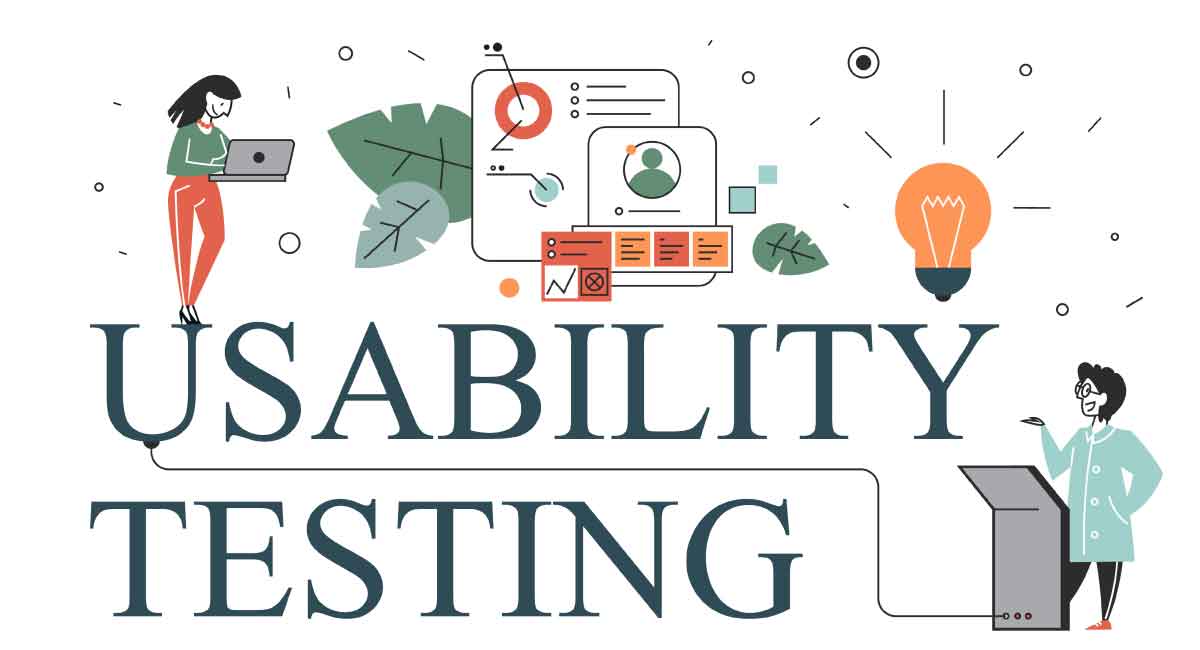With users increasingly focused on experience while interacting with digital applications, it’s only natural that (UX) and user interface (UI) are top priorities for building digital products.
In this article, we will dive deep into usability testing, which is crucial for effective UX and UI design. We will go through its types, benefits, and examples. Lastly, we will cover the advantages of choosing comprehensive online UI UX training to gain a competitive edge in the UI UX job market.
What is Usability Testing?
Usability testing is a practice to assess a digital product or service for its readiness for a commercial release. It involves utilizing a group of real users to test the product and give feedback regarding its ease of use to achieve certain critical tasks associated with the product.
The motive is to conduct UX testing of the product for any flaws or issues and eliminate them for a smooth UX experience.
Also Read: UX Designer Resume Writing Guide With Template
What is the Purpose of Usability Testing?
Usability testing is a cornerstone in the commercial success of a product. It serves several critical purposes, such as:
- Examine how real users interact with the application
- Modify the application based on feedback
- Identify flaws that may occur only on external devices while going unnoticed on the developers’ devices
- Detect problems in the navigability of the application
- Note the myriad of experiences of various user personas
- Collect data for quantitative analysis of the UX testing experience
- Reveal the undetected issues that may interfere with the usability of the application
- Save money by ironing out issues early on, rather than releasing a poorly designed product and suffering from bad reviews or serious recalls
Understanding the Types of Usability Tests and Usability Testing Methods
Types of Usability Tests
The immense variety of digital applications demands an array of usability tests to suit certain scenarios, features, and industries. Let’s look at some of the popular types of usability tests:
- Remote: Remote usability testing is conducted in a scenario where the researcher and the participant are located at different places. The surge in the use of online tools has recently increased the use of this type of usability testing.
- In-person: An ‘in-person’ usability test may be conducted when the application demands specific system requirements. Here, the participant will use the application in the researcher’s presence. This is pertinent when the researcher is looking for not just the user data but also the personal impact of the application, such as expressions and body language, which are great indicators of the feelings generated in the user due to the UX design.
- Moderated: Moderated usability testing involves constant communication between the researcher and the user throughout the testing period. The researcher assists the user at each step of the task completion. The researcher conducts a qualitative analysis of the impact of the product on individual thought processes.
- Unmoderated: Unmoderated usability testing is the most flexible testing type, as it works through an online link generated for the test. The users can complete the test at their convenience from their location. Specialized tools may be used to prepare the tests for easy access and navigation.
- Qualitative: Qualitative usability testing, as the name suggests, relies on qualitative data such as the feelings and experiences of the user while navigating and using the application. It assesses the requirements, expectations, and issues the users face while testing.
- Quantitative: Quantitative testing entails collecting numerical data about the various aspects of tasks completed by the users, such as the total task completion time, satisfaction rate, errors, preferences, etc. It requires a detailed analysis of the data to arrive at an objective scenario of the application’s usability, statistics, and benchmarks.
- Explorative: Explorative usability testing involves questioning the participants about their views, thoughts, and feelings. This is usually conducted for a small group of participants during the initial developmental stages to discover novel features and market demands.
- Comparative: Comparative usability testing provides the participants with two or more versions of an application. It involves comparing the data from the different versions vis-a-vis the user preferences and arriving at the final version.
Also Read: How To Learn UI UX Design: A Beginner’s Guide
Types of Usability Testing Methods
While there may be an overlap of one or more types during usability testing, the method of testing defines how the required parameters are achieved. Here are some of the chief methods used.
- A/B testing: A/B testing involves releasing two versions of an application for different groups of participants. The final version is chosen as whichever type receives a more favorable user review.
- Card sorting: This involves participants organizing the different aspects of the application in groups and labeling them according to their logic and thought process. This is typically used for testing the comprehension of names to be given to the interfaces, pages, buttons, or screens.
- Recording: Recording of video, audio, or screen is likely to reveal qualitative and subtle user information such as a pause before a click, an expression of frustration when the user is unable to find the desirable option or the involuntary verbal clues of happiness and relief. These recordings help the researcher scrutinize the qualitative impact of the application multiple times at a later stage.
- Guerilla testing: This type of testing is conducted randomly at different locations, asking people to test the product and give quick feedback. This is useful to note the first impressions that the product may have on the users and how likely the users are to continue to navigate or return to the product in the future.
- Contextual inquiry: Contextual inquiry involves the researcher evaluating the completion of a task in an environment comfortable for the participant. This method helps assess the systems’ usability specific to the participant and the issues encountered therein.
Components of Usability
The usability is based on five components that form the basis of any testing type or method. These components enable the researchers to scrutinize the application’s user data for a streamlined UX experience.
Learnability
Learnability implies that the application must be easy to learn and use. The application will not be commercially successful if a user has to go through multiple help documents to achieve even simple tasks.
Efficiency
Efficiency is related to how effectively the users can navigate and achieve their goals of using the application. Even if the learnability of the application is good, completing the task requires complex loops, and the user will remain dissatisfied with the result.
Memorability
The simplicity of the application should be such that the user will not only remember the application but also return to use it. The application should not have complicated navigation, and the user should be able to reuse it without any extra effort.
Errors
This component works in two ways. First, the product should be designed to account for flaws and have relevant error messages popping up at the right time. Second, if the user goes wrong in navigation, such as closing the window before saving the data, the application should be able to take care of the error and fix it.
Satisfaction
The user should close the application with a satisfied mind that the goal of the application has been accomplished. While some users may complete the tasks, they may not return if they have encountered difficulties, such as a long time for payment completion on e-commerce websites. Hence, the satisfaction of the user is crucial.
How Usability Testing is Different from User Testing
While some use the terms interchangeably, there are marked distinctions between user testing and usability testing.
User testing is primarily related to the users, focusing on their requirements, wishes, and difficulties. The researcher evaluates how their product fits into these parameters.
Usability testing, on the other hand, requires evaluation of the actual product from the perspective of various user personas and user-specific conditions.
For example, a company has developed a website to sell kitchen knives. The user testing would involve asking various participants what they require from the website, such as information about the longevity of the blade sharpness, testing video of the handle, video to demonstrate the ability to cut through soft as well as hard vegetables, and simple payment gateways with a cash-on-delivery option.
Usability testing would entail asking users to try using the website to order the knives in different shapes and colors. The users may review the information and videos, which may also affect their purchasing choices. The usability testing would include examining the data related to such user experiences.
This example may indicate that usability testing is performed only after the total completion of the production. However, that is not the usual case. Let’s read on to know why.
Also Read: UI/UX Design Trends for 2024
Formative vs. Summative Usability Testing
In addition to the types of usability testing described previously, two more categories may overlap with any of them. These are formative and summative usability testing.
As the name suggests, formative usability testing is conducted when the product is still being formed, which means it is in the early design and developmental stages. Here, the product is not released to too many users. Only a few users (around 5 to 10), some of them working on the product themselves, are involved in the testing.
On the other hand, summative usability testing is performed after the product has been finished and is now on the path to a commercial release. Here, the number of users selected for testing ranges from 15 to 20.
Further, formative testing assesses wireframe prototypes in a majorly qualitative manner. However, summative testing is quantitative and conducted on fully functional prototypes.
Phases of a Usability Study
We have reviewed the fundamentals of usability testing. Now, let’s delve into how this study is conducted. Here is a list of the major phases of a usability study:
- Determine whether you want to test certain parts or the entire application
- Establish the tasks specific to the test subject
- Identify the parameters associated with the tasks
- Set the limits and benchmarks for the parameters
- Create a study plan that includes the goals of the study, the research question, the requirements of the users, the questions to be asked to the users, methods to be used, etc
- Assemble the research team and delegate roles and tasks to the team members, such as moderating, recordings, data collection, and user registrations
- Search and identify the right group of participants for the product, most closely resembling the final target user base
- Perform the usability testing for the participants
- Collate and analyze the data for further investigation of the trends
- Consolidate and report the findings and include recommendations for rework of the product if required
Top Benefits of Usability Testing
The market size of usability testing tools is expected to reach $2199.65 million by 2027. Clearly, businesses are investing more and more in usability testing. Here’s why.
- Helps iron out the kinks in the application before release
- Enables cost savings on future defects
- Prevents damage to reputation if a bad product is released without testing
- Highlights aspects such as the difficulties faced by disabled people while navigating the applications
- Critically examines the application for unbiased and accurate feedback
- Can be conducted conveniently
- Enhances customer satisfaction and conversion rates
For those aspiring to enter the UI UX industry, a well-designed UI UX program will arm you with the skills to leverage these benefits, making you invaluable for top employers in the field.
Also Read: What is a UI Developer? A Comprehensive Guide
Usability Testing Examples
Let us now go through a couple of examples to demonstrate how usability testing is conducted:
E-commerce website for jewelry
The typical requirements of a jewelry website are that the users must be able to view the jewelry in both high and low magnification, there must be a variety of choices, and the users must be able to see how the jewelry would look when worn. Hence, a typical usability test would include the following steps:
- Select the group of participants, say women in the age group of 20-35 years.
- Define the tasks to be completed, such as searching for a necklace, going through the photos, selecting a necklace, completing the payment, and receiving the confirmation message.
- Monitor the progress of the participants and note their verbal and non-verbal cues.
- Provide comment boxes for each step of the task.
- Ask for final feedback on the usability.
Online game
Online gaming software typically requires advanced graphics, smooth scene transitions, intricate storylines, good character development, and streamlined navigation. Here’s how usability testing for an online game can be conducted:
- Select a demographic of participants for testing.
- Give participants access to the advanced features of the game.
- Record the audio, video, and screens to capture the feelings and expressions of the gamers.
- Ask them for feedback regarding the graphics for each task.
- Include A/B testing to analyze how the prices of the advanced features can affect the purchase of the game.
- Ask for final feedback on the entire gaming experience.
Usability Case Study
The mobile application for the popular clothing brand Zara was subjected to usability testing. This involved personas and the related stories of why they would want to buy clothes from Zara, such as professionals requiring formal wear and preferring to order from the app.
The usability testing involved asking questions such as “You see a coat you might like. Can you walk me through how you would decide whether this is a coat for you?” The response to the questions was noted in the form of the actions taken to go through the mobile app and purchase the garments.
Data analysis using an affinity map and 2×2 analysis revealed problems related to adding or removing items from the shopping cart. This problem was then focused upon to design a new interface. The new interface was then subjected to usability testing. The task success rate increased from 33 to 100 percent, highlighting the effectiveness of the testing methodology.
Learn Usability and Other UI UX Skills
Usability testing is essential to ensure a smooth release of a digital product or service. The understanding and working knowledge of usability testing methods and tools are must-have skills for UX professionals.
Whether you’re an aspiring UX designer or currently working as a UX designer looking to upskill, continuous learning can be key to your success. If you want to enhance your knowledge and open up career opportunities, industry-recognized courses, like this UI UX Bootcamp, will help you.
This bootcamp has been structured with the goal of imparting knowledge about UI UX design principles, prototyping, styling, testing, and research. Led by reputed instructors with extensive industry experience, you can gain a solid conceptual base and a great opportunity to apply your learnings.
Also Read: UX Researcher Job Description
FAQs
#1. What is usability testing in UI UX?
Usability testing is a method to examine the ease of use of an application by involving users to test the application. It is an exercise to determine how easy it is for the users to navigate a product and how likely they are to reuse it.
#2. How do you conduct UX usability testing?
Usability testing requires several steps. Here is a brief list of the major ones:
- Define the problem
- Plan the study
- Select the user group
- Conduct study
- Analyze results
#3. What is the difference between user testing and usability testing?
User testing requires a study of the requirements and demands of the users, while usability testing entails recruiting users to test the ease of navigation and use of the product. User testing is always conducted during the design of the product, while usability testing may be conducted during the design as well as before the release of the product.
You might also like to read:
Guide to UX UI Design Companies
UX Researcher Salary in 2024: Here’s How Experienced & Entry-Level UX Researchers Earn
How to Improve the UI/UX of a Website?
UX Design Process: Steps, Importance, & Everything You Should to Know







